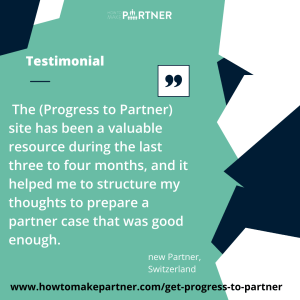When it comes to submitting your Business Case for Partnership, you are often given a form or proforma to fill in. In this blog post we cover our best tips to make your Business Case really stand out. This is especially important when you are forced into using a very restrictive format or document.
Use visuals and graphs wherever possible in your Business Case for Partnership
As the saying goes, a picture is worth a thousand words. And when it comes to your Business Case for Partnership this is really the case. If you can add in some visuals it can really help you get across the promise of your Business Case. However, we are seeing a trend – particularly from Big 4 firms – where the proformas everyone has to use to submit their Business Case for Partnership can only include text. So no pictures and no visuals allowed! In this scenario you really need to take care with your choice of words.
Start with the best stuff first
It’s tempting to start your Business Case for Partnership with a lot of context. Perhaps you’d like to give the person reading your Business Case some context about you and your background.
Don’t do this. Seriously. Start with the best stuff first.
The stuff that shows the promise of your Business Case for Partnership. What is going to be the size of your client portfolio? By when and with what profit margin? This is what your partners are wanting to read and wanting to know.
This is what will instantly get your partners on side and interested to know more about how you are going to achieve your bold statements about the growth of your practice.
One of our most sought-after courses in our subscriber-only site Progress to Partner is called “How to Build a Cast-Iron Business Case for Partner”. We think it’s a must-have in your arsenal of tools and guidance to help with your career progression. There is also a section on the Partnership Admissions process with guides and recordings to help you find your way through the system. Check it out!
Make every word fight for its place
You’ve been living and breathing your Business Case for Partnership for ages! It’s natural that you will want to put EVERYTHING about it in your written Business Case submission. The problem is that the more detail you put in, the harder it becomes to see the wood for the trees. This is why I recommend that you start with a 1-sentence sell. Only then progress to a 3-sentence sell and then build your Business Case up from the 3-sentence sell. This technique helps to make sure your Business Case for Partnership is crisp and impactful.
There’s a balance to be made between giving enough detail so that Partners have confidence that you know what you are talking about, and going overboard where the essence of your Business Case for Partnership becomes lost in the overall submission.
Get someone to edit your Business Case for you
 I’ve just been editing a Big 4 Business Case for Partnership. The Big 4 firm has asked their partnership prospects to submit a document to pitch their Business Case in under 500 words. If you have built your Business Case using the STAGe model and a 1-page Talksheet this will be easy. Using someone else to edit your Business Case submission can help you cut out the waffle and make sure that what you have written is easily understood.
I’ve just been editing a Big 4 Business Case for Partnership. The Big 4 firm has asked their partnership prospects to submit a document to pitch their Business Case in under 500 words. If you have built your Business Case using the STAGe model and a 1-page Talksheet this will be easy. Using someone else to edit your Business Case submission can help you cut out the waffle and make sure that what you have written is easily understood.
What’s in Progress To Partner Academy to help you with your Business Case for partner?
Progress to Partner Academy is full of resources, guides and recordings and 14 courses all to give you the skills and knowledge and confident to progress in your career. It’s all tailored to people working law firms, accountancy & consultancy firms so the advice will all be relevant.
Find what you need to watch or read at the time you need it. Within the site you’ll find over 150+ resources including 14 Courses, videos, checklists, templates and plans to help you progress your career to partner. Amongst the many curated resources (no more unnecessary scrolling or searching) you’ll find:
- On-demand courses on how to create and articulate your business case, including our most downloaded course “How to Build a Cast-Iron Business Case for Partner” (find out more about this course here)
- A section on the Partnership Admissions process with guides and recordings to help you find your way through the process with your sanity intact.
- Recordings and checklists on how to ace your partner panel interview
- On-demand courses on how to win the right sort of clients
- Proven advice on how to still do the day job and find the time to get through the Partner Track process
Learn more about Progress to Partner Academy and join here








